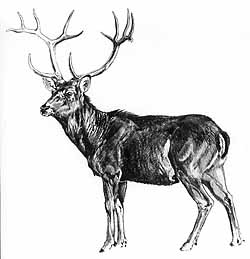English: Swamp Deer or Barasingha; French: Cerf de Duvaucel; Annamese: Bhelingi-pohu; Central India: Goiniak; Hindi: Barasingha, Maha; Mandla: Bara-Ner-wari, Sal-Samar; Nepali: Gonda, Baraya, Gonn, Ghos; Tamil: catuppunila man.
 |
Former distribution: The swamp plains along the rivers in northern India, the Terai in Nepal, south to the central Provinces and east to Assam and Thailand.
Present distribution: India along the river Ganges and the Terai in Nepal, south to the central Provinces, east to Assam. Introduced into England, Woburn Park and Texas, USA.
Behaviour: Preferred habitat: along the rivers, in swamps on the edge of woods, in grass plains; the proximity of water is essential. They live in small herds, are active mainly diurnally, and graze on plants and grasses. The rut begins late December. Predators include man, leopards and tigers.
Population status: Rare. Estimated numbers: Nepal about 1000; northern India and Assam 4000-5000; central India: 200. Populations are increasing.
Brief notes:
Body weight: 170-180 kg
Head and body length: 120-200 cm
Tail length: 7-15 cm
Shoulder height: 115-120 cm
Gestation period: 8 months
Maximum age: 18 years
Trophy: Record SCI: 119 5/8 score, 1968 India, CHARLES BAZZY; average 70 score.
RW’s: 165 7/8 points, 1958 C.P. India, E.T. GATES; average 85 points.
Hunting methods: Stalking and on elephant-back. Protected by law.
Subspecies: 4
1. Cervus d. duvauceli Northern India along the Ganges and in Assam. Rare.
2. Cervus d. branderi Central India. Endangered.
3. Cervus d. ranjitsinhi Northern Bengal and Assam. Rare.
4. Cervus d. schomburgki Central Thailand. Extinct.
Remarks: Probably one subspecies, Cervus d. schomburgki (Schomburgk’s Deer), became extinct in 1931. Searches for a possible unknown survivor are still going on, so far without result. The distribution area included the great swamps in Central Thailand, around Paknam Po and Muang Petchabun. Many authors consider Schomburgk’s Deer as a separate species. The author follows H. POHLE (1955), who stated that C. schomburgki was related to C. duvauceli.






